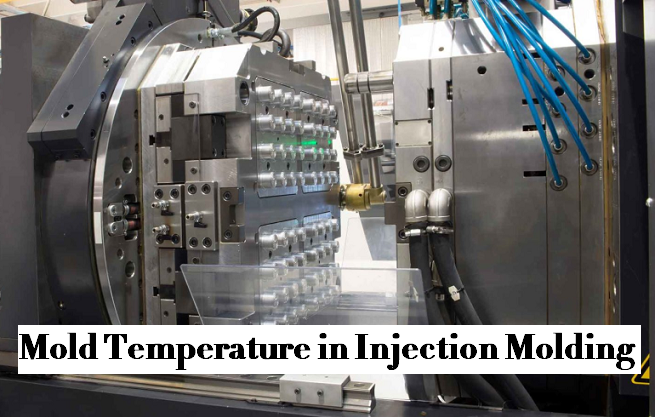When we are trying to get the optimal result of injection molding, the smallest details often should be considered, not to mention the temperature control. In this article, we’ll talk about the injection mold temperature, what is it, and how it works during the process.

What is Mold Temperature in Injection Molding?
Mold temperature in injection molding refers to the surface temperature of the mold cavity in contact with the plastic parts during the process. The injection mold temperature has an obvious influence on the appearance, dimensional accuracy, and properties of the plastic molded parts. It also influences the production, subsequent processing, and final application of products.
For the most part, mold temperature is one of the most fundamental control factors in the injection molding process, and it is also the most important factor to consider when designing a mold. The recommended mold temperature is 130℃ to 150℃.
How Injection Mold Temperature Affects the Quality of Plastic Molded Parts?
1. Product appearance
The fluidity of resin may be improved by increasing the temperature, which will typically result in smooth and glossy surfaces on the components, and in particular, the surface attractiveness of glass fiber reinforced resin parts will be improved. Additionally, it increases the strength and aesthetics of the fusion line. If the mold temperature is too low for the etched surface, it is difficult for the melt to fill the root of the texture, resulting in a brilliant product surface and “transfer” that does not reach the true texture of the mold surface. After raising the mold temperature and the material temperature, the perfect etched effect on the product surface may be achieved by sintering the product.
2. Internal stress of products
The development of internal tension during the cooling process is primarily produced by varying degrees of thermal shrinkage throughout the chilling process. Following the formation of the product, the chilling process gradually spreads from the surface to the inside of the product. The surface shrinks and hardens initially, and then the interior shrinks and hardens progressively. Internal tension is created during this phase as a result of the disparity between the rates of shrinking and expansion. Cracks will appear on the surface of a plastic component when the residual internal stress in the plastic part exceeds the elastic limit of the resin, or when the plastic part is subjected to the erosion of a certain chemical environment, for example. When transparent resins such as PC and PMMA are studied, it is discovered that the residual internal tension is compressed in the surface layer and expanded in the interior layer.
The compressive tension at the surface is dependent on the surface cooling state. The molten resin cools fast in the cold mold, resulting in a high level of residual internal tension. Mold temperature is the most fundamental factor for regulating internal tension in an injection mold. A little variation in mold temperature will have a significant impact on the mold’s residual internal stress. In general, the allowable internal stress of each product and resin has a minimum mold temperature limit that must be adhered to at all times. It is recommended that the mold temperature be greater than the minimum during general formation when creating thin walls or long flow distances.
3. Improve product warpage
Plastic components will stretch and deform owing to insufficient cooling if the mold cooling system is designed in an inappropriate manner or if the mold temperature management is performed incorrectly. For the purpose of controlling mold temperature, the temperature difference between male and female molds, mold core and mold wall, mold wall and insert, and mold core and insert shall be determined according to the structural characteristics of products, so as to offset the orientation shrinkage difference and avoid the warpage and deformation of plastic parts according to the orientation law by controlling the different cooling shrinkage speed of each part of molding and drawing the plastic parts to the mold wall and insert. To ensure that the cooling of all areas of the plastic parts is evenly distributed, the mold temperature must be maintained at a constant level for plastic parts with totally symmetrical shape and structure.
4. Product shrinkage
Because a low mold temperature accelerates the “freezing orientation” of molecules, a low mold temperature increases the thickness of the frozen layer of melt in the mold cavity, and a low mold temperature inhibits the growth of crystallization, a low mold temperature can reduce the molding shrinkage of products. As a result of high molding temperatures, melt cooling occurs slowly and gradually cools over a prolonged period of time. Additionally, the orientation level is low, which promotes the formation of crystallization, resulting in substantial shrinkage of the finished product.
5. Thermal deformation temperature of the product
When crystalline plastics are produced at a low mold temperature, the molecular orientation and crystallization are instantaneously fixed, which is especially true for crystalline plastics. A partial rearrangement and crystallization of the molecular chain will occur in a high-temperature service environment or secondary processing conditions, causing the product to deform even at temperatures much below the thermal deformation temperature (HDT) of the material.
The correct method is to use a mold temperature that is close to its crystallization temperature for production, so that the product can be fully crystallized during the injection molding stage, and thus avoid this post crystallization and post shrinkage in the high-temperature environment, which is the most common cause of failure.
